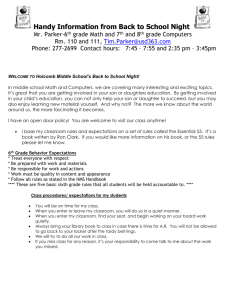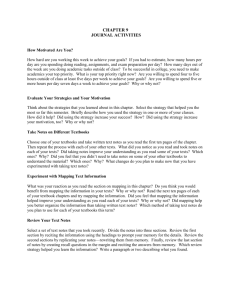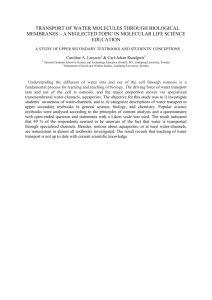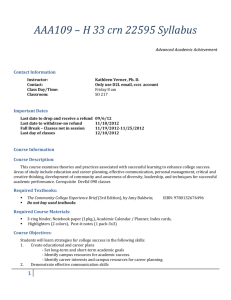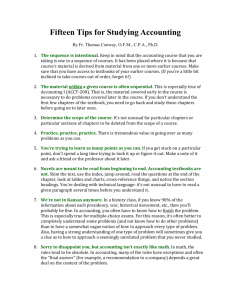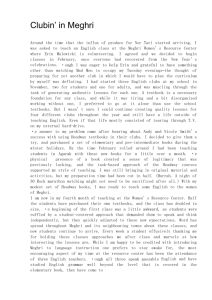In a Digital Future, Will Textbooks Disappear?
advertisement
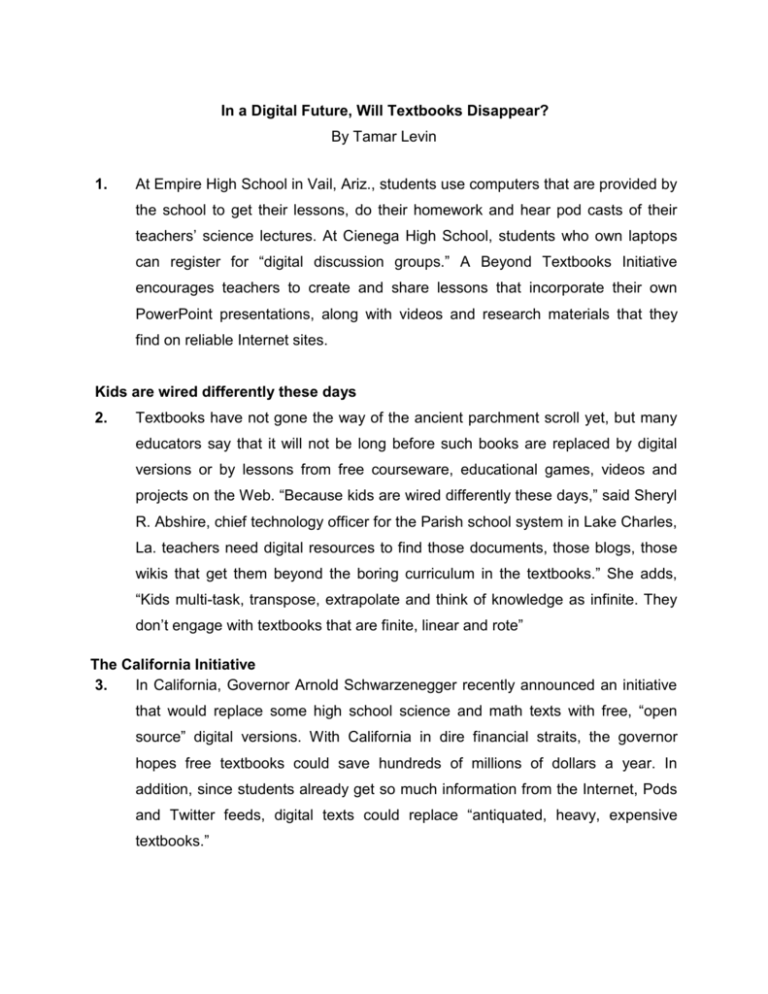
In a Digital Future, Will Textbooks Disappear? By Tamar Levin 1. At Empire High School in Vail, Ariz., students use computers that are provided by the school to get their lessons, do their homework and hear pod casts of their teachers’ science lectures. At Cienega High School, students who own laptops can register for “digital discussion groups.” A Beyond Textbooks Initiative encourages teachers to create and share lessons that incorporate their own PowerPoint presentations, along with videos and research materials that they find on reliable Internet sites. Kids are wired differently these days 2. Textbooks have not gone the way of the ancient parchment scroll yet, but many educators say that it will not be long before such books are replaced by digital versions or by lessons from free courseware, educational games, videos and projects on the Web. “Because kids are wired differently these days,” said Sheryl R. Abshire, chief technology officer for the Parish school system in Lake Charles, La. teachers need digital resources to find those documents, those blogs, those wikis that get them beyond the boring curriculum in the textbooks.” She adds, “Kids multi-task, transpose, extrapolate and think of knowledge as infinite. They don’t engage with textbooks that are finite, linear and rote” The California Initiative 3. In California, Governor Arnold Schwarzenegger recently announced an initiative that would replace some high school science and math texts with free, “open source” digital versions. With California in dire financial straits, the governor hopes free textbooks could save hundreds of millions of dollars a year. In addition, since students already get so much information from the Internet, Pods and Twitter feeds, digital texts could replace “antiquated, heavy, expensive textbooks.” 4. “In five years, I think the majority of students will be using digital textbooks, which can be better than traditional textbooks,” said William M. Habermehl, superintendent of the 500,000-student Orange County schools. Schools that do not make the switch, Mr. Habermehl said, could lose their constituency. “We’re still in a brick-and-mortar, 30-students-to-1-teacher paradigm,” Mr. Habermehl said, “but we need to get out of that framework. The new paradigm will be 200 or 300 kids taking courses online, at night, 24/7. The threat to schools in Orange County,” he added, is the digital world. There someone will offer brilliant $200 courses in French or in geometry by the best teachers in the world and students will opt to study digitally and not in the classroom.” There is still a large digital divide 5. But the digital future is not quite on the horizon in most classrooms. For one thing, there is still a large “digital divide.” This means there is a gap between people with access to digital and information technology and those with very limited or no access. Not every student has access to a computer, an electronic reader device or a smartphone, and few school districts are wealthy enough to provide them. So digital textbooks could widen the gap between rich and poor. For example, in California’s 24,000-student Chaffey Joint Union High School District, where almost half the students are from low-income families, a large portion of the kids don’t have computers at home, and it would be too costly to print out the digital textbooks. 6. At the same time, elsewhere in California, education authorities are reviewing 20 open-source high school math and science texts. They will announce the ones that meet state standards so teachers can begin to use them now. Digital textbooks, let students and teachers use the best lessons taught by the most dynamic teachers,” according to John A. Roach, superintendent of the Carlsbad, Calif., schools who assures us, nonetheless, that they’re not going to replace paper texts right away.” 7. Many educators expect that the number of digital textbooks and online courses will start small. Perhaps only those who want to study a subject they cannot fit into their school schedule or those who need a few more credits to graduate will take advantage of this option. A Threat to Traditional Textbook Publishers 8. Whenever it comes, the online attack —the competition from open-source materials — poses a real threat to traditional textbook publishers. To cope with this, Pearson, the nation’s largest textbook publisher, has four texts already available online. California can use them as free supplements to their texts, according to the publisher. Pearson believes the world is going digital, so they provide digital and print, and see what our customers want. 9. CK-12 Foundation is a non-profit group that develops free “flex books” that can be customized to meet state standards, and added to by teachers. “The good part of our flex books is that they can be anything you want,” said Neeru Khosla, a founder of the group. “You can use them online, you can download them onto a disk, you can print them, you can customize them, you can embed video. When people stop demanding textbooks as the only legitimate teaching tool, they’ll see that there’s no reason to pay $100 for a textbook when you can have the content you want free.” Most of the digital texts submitted for review in California came from this nonprofit group. 10. The move to open-source materials is well under way in higher education. President Obama has proposed creating free online courses as part of his push to improve community colleges. Around the world, hundreds of universities, including M.I.T. and King Fahd University of Petroleum and Minerals in Saudi Arabia, now use and share open-source courses. 11. Vail’s Beyond Textbooks effort in Colorado has moved in that direction. In an Empire High School history class on elections, for example, students created their own political parties, campaign Web sites and videos. “Students learn the same concepts, but in a different way,” said Matt Donaldson, Empire’s principal. Our teachers have identified whatever resources they feel best covers their courses, such as a project they created themselves or an interesting site on the Internet but they generally do not take chapters from textbooks.” 12. For all the attention to the California initiative, digital textbooks are only the start of the revolution in educational technology. “We should be bracing ourselves for many more interactive, many more engaging videos, activities and games,” said Marina Leight of the Center for Digital Education, which promotes digital education through surveys, publications and meetings. But given the economy, many educators and technology experts agree that the K-12 digital revolution may be further off. But it is really going to happen. Published in the Education section on August 9, 2009 http://www.nytimes.com/learning/teachers/featured_articles/20090826wednesday.html In a Digital Future, Will Textbooks Disappear? - Comprehension Questions 1. What is the purpose of the examples in paragraph 1? a. To show how students do their homework using digital technology. b. To illustrate the various ways in which computers are used in schools. c. To encourage teachers to use textbooks instead of Power Point presentation. d. To claim that computers are used instead of books in science lectures only 2. Complete the following sentence (no more than SIX WORDS) Teachers need digital resources to extend the boring curriculum in the textbooks, since_________________________________________ 3. Paragraph 3 What are the reasons for replacing textbooks with digital versions? a._____________________________________________ b._____________________________________________ 4. Paragraph 5 The use of digital textbooks is already widespread in schools. True / False Quote from the text to support your answer __________________________________________________________ 5. Complete the following sentence: The author mentions California's Joint Union High School to illustrate the idea that _________________________________________________________________ 6. Paragraph 7 How many categories of students will take online courses? _______ 7. Paragraph 8 a. What does Pearson have to cope with? ___________________________________________________ b. How does he cope with this? He_________________________________________________ 8. List 3 advantages of flex books? a._________________________________________________________ b._________________________________________________________ c._________________________________________________________ 9. a. Circle the correct word : President Obama encourages / discourages digital education. b. Quote from the text to support your choice. ________________________________________________________ 10. Paragraph 11 What “direction" (L1) does the author refer to? ___________________________________________________________________ 11. What is the writer's purpose in writing this article? a. To prove that digital technology will widen the gap between poor and rich students. b. To report on the CK Foundation efforts to develop free flex books. c. To show that digital textbooks will eventually dominate the educational system. d. To publicize Governor A. Schwarzenegger's democratic initiative.


